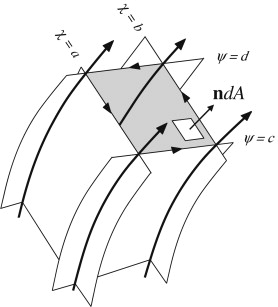\[ \rho \mathbf{u} = \nabla \times \mathbf{\Psi} \]
It can be specified in terms of two scalar functions
\(
\mathbf{\Psi} = \chi \nabla \psi
\)
Putting this specification for \( \mathbf{\Psi} \) into \(\rho \mathbf{u} = \nabla \times \mathbf{\Psi}\) produces
\(
\rho \mathbf{u} = \nabla \chi \times \nabla \psi,
\)
because the curl of any gradient is identically zero
[Q] Use Stokes’ theorem to prove that
\(
\nabla \times (\nabla \phi) = 0
\)
for any single-valued twice-differentiable scalar \( \phi \) regardless of the coordinate system
[Pf] \(\because\) Stokes theorem
\(
\iint_A (\nabla \times \mathbf{u}) \cdot \mathbf{n} \, dA = \int_C \mathbf{u} \cdot \mathbf{t} \, ds
\)
Let \( \mathbf{u} = \nabla \phi \) \(\because\) \( \mathbf{t} \) vector points along the contour \( C \) that has path increment \( ds \)
\(\therefore\) Note \( \nabla \phi \cdot \mathbf{t} \, ds = \left( \frac{\partial \phi}{\partial s} \right) ds = d\phi \)
\(\therefore\)
\(
\iint_A \left( \nabla \times \left[ \nabla \phi \right] \right) \cdot \mathbf{n} \, dA = \int_C \nabla \phi \cdot \mathbf{t} \, ds = \int_C d\phi = 0
\), the final equality holds for integration on a closed contour of a single-valued function \( \phi \)
\(\therefore\) For an arbitrary surface \( A \) of any size, shape, orientation, or location, this can only be true if
\(
\nabla \times (\nabla \phi) = 0
\)
If \( \nabla \times (\nabla \phi) \) were nonzero at some location, an area integration in a small region centered on this location would not be zero. Such a nonzero integral is not allowed, thus \( \nabla \times (\nabla \phi) = 0 \) must be zero everywhere because \( A \) is arbitrary
\(\Rightarrow\) the mass flux \( \rho \mathbf{u} = \nabla \chi \times \nabla \psi \) will be parallel to will be parallel to surfaces of constant \( \chi \) and constant \( \psi \)
\(\Rightarrow\) three-dimensional streamlines are the intersections of the two stream surfaces, or stream functions in a three-dimensional flow

Consider two members of each of the families of the two stream functions
\(
\chi = a, \chi = b, \psi = c, \psi = d
\)
The mass flux \( \dot{m} \) through the surface \( A \) bounded by the four stream surfaces is calculated with area element \( dA \), normal \( \mathbf{n} \), and Stokes’ theorem